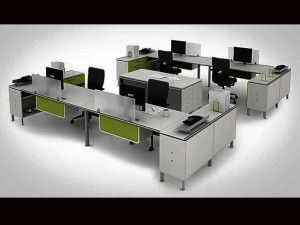The evolving workspace

THE FURNITURE for today’s workforce: Workstations that come with panels in various heights, integrated hanging storage shelves, marker boards, nametag holders, ample (and novel!) storage boxes, bag holders, movable fabric panels and acrylic privacy screens.
If you are part of the greater working population, you likely spend more time at the workplace over any other place during the day. Given that, have you ever wondered if your body is properly carried or supported by your chair and worktable? Do your sensory and tactile requirements support your activities and make your work more enjoyable? Do you have the appropriate amount of privacy or inversely, are you allowed an adequate degree of interaction with your coworkers?
All these criteria have turned the design of environments and the manufacturing of office furniture into a sophisticated industry harnessing art, technology and the human psyche.
When we speak of design, we are essentially speaking of our human-built environment. As you look around you, practically everything you see is a product of design. The process of designing was created to provide the tools and the environment needed to support human activity.
Keep improving
From functional needs alone, the process of design grew to cater to more whimsical desires, and evolved in flourishing civilizations to become a tool for creating objects for comfort and pleasure. The creative process has grown leaps and bounds and has expanded in terms of its purpose and its contributions to human civilization. Design will continue to evolve as human needs change, and it will keep improving for as long as science provides the means to rethink, retool and recreate what we already have.
Article continues after this advertisementLast week, I was at the launch of the new Steelcase office furniture systems. Steelcase is one of the pioneers in its industry, having been established in the early 1900s. In the ’80s and ’90s, it was not only a prominent brand, but also a pioneer in the design of high-performance system partitions, ergonomic chairs and worktables.
Article continues after this advertisementVery recently, Steelcase bought into an Asian manufacturer and is now producing office furniture in the region. These Asian-made systems furniture not only carry a friendlier price, but also have been designed in consideration of the Asian scale, culture and workplace habits.
Dynamic changes
Long ago I wrote about the various generations: the Baby Boomers, Generation-X, Generation Y and Generation Z, each one like a subset of the human populace, born into a certain point in history, within certain socio-economic circumstances and into a particular stage of technological development, with all these ultimately molding its outlook in life. Each generation has its own concept of work and of living.
These dynamic changes in the demographics and psychographics of the various generations are what makes the lives of designers more challenging, for they have to keep abreast with the changing rules of the workplace. The current workforce is composed mostly of “Generation Y,” a peer group with members that are characteristically more conscious of their identities and sense of individuality.
They love to bring their personal belongings to their worktables, are empowered when allowed to maneuver in their own work style, and are conscious of the work-life balance. They long to express their identity and uniqueness through their workspaces. Ironically, “Generation Y” is also egalitarian, with a deep dislike for hierarchy and a preference for working in teams. Being very much involved in social issues, it wants to change the world and knows that the collective power of many can influence policies and transform the status quo.
Appealing to people
During their product launch, Steelcase demonstrated how their new system furniture took this generation into account. Their workstations came with panels in various heights, integrated hanging storage shelves, marker boards, nametag holders, had ample (and novel!) storage boxes, bag holders, movable fabric panels and acrylic privacy screens. I was quite amused by their systems for they had thoroughly looked into the Generation Y lifestyle, while still appealing to people of my Generation X and the Boomers.
Fortunately for today’s workforce, technology can provide for all the whims they desire. On the commercial aspect, a comfortable workspace sparks creativity and promotes efficiency. That’s why the office system furniture industry thrives, because ultimately, happy workers translate to better profits and a flourishing business. Which brings me back to the issue of how much time we should really be spending in our workspaces. For the greater majority that is the work-life balanced Generation Y, they’ve probably already figured it out for themselves.
Steelcase is distributed locally by Ultra Modular Concepts Inc. ([email protected]).
Contact the author through [email protected] or through our Asuncion Berenguer Facebook account.